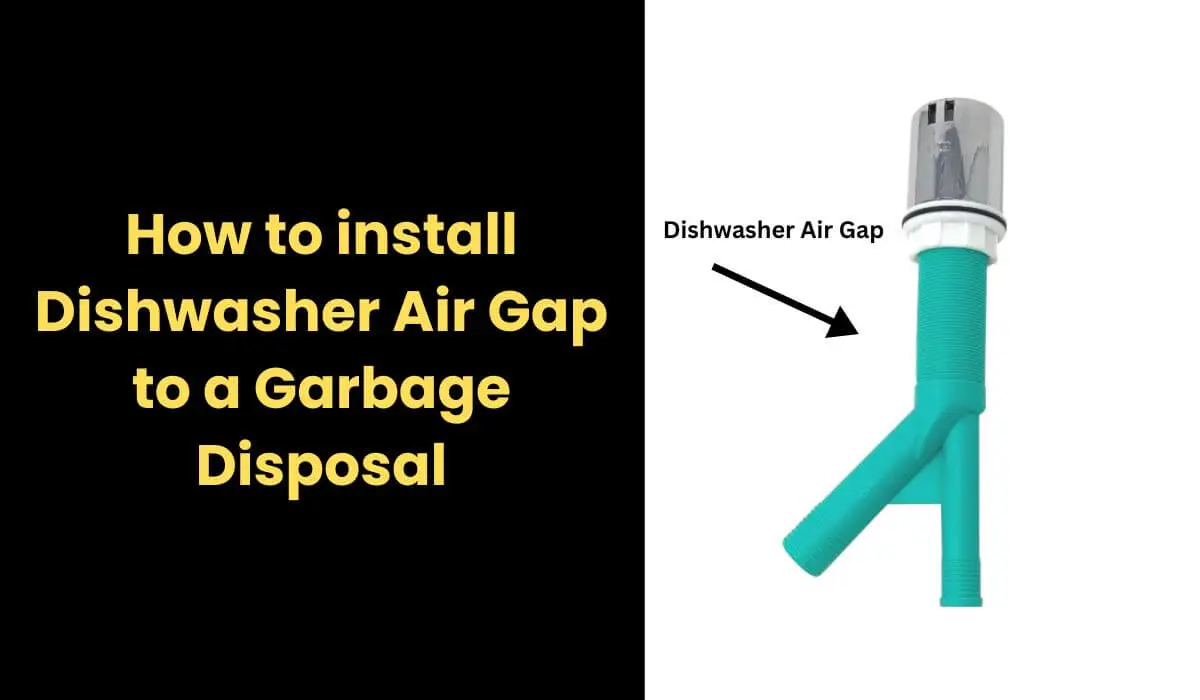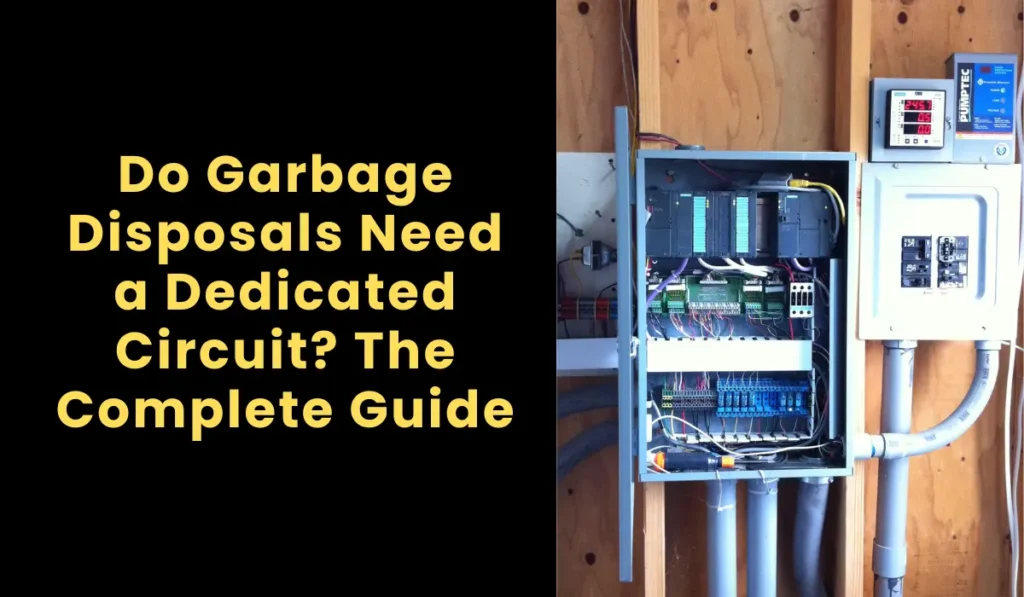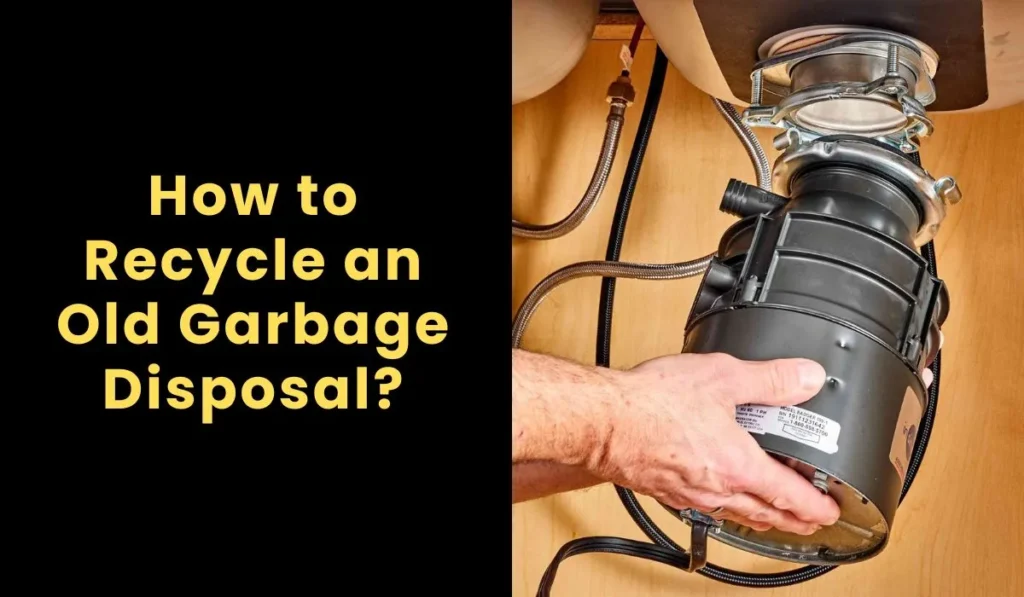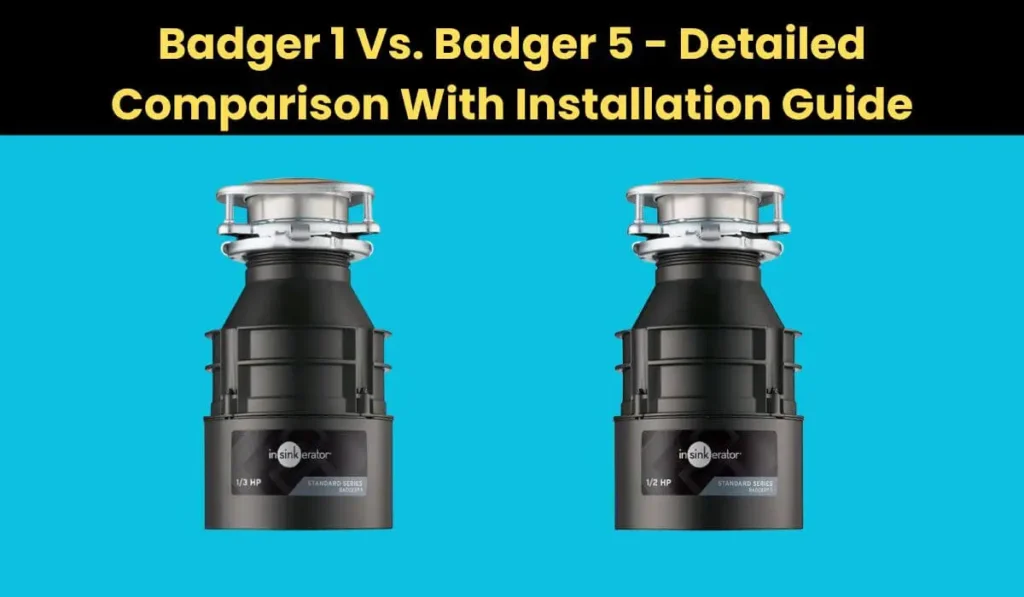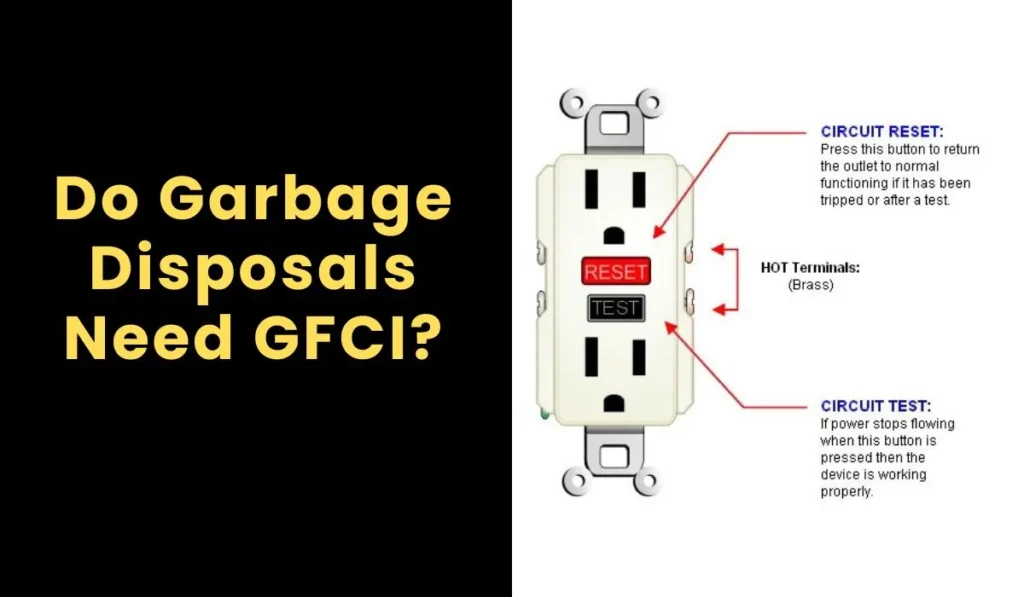How to install Dishwasher Air Gap to a Garbage Disposal
Installing a dishwasher air gap is one of those small upgrades that makes a big difference in keeping your kitchen clean, safe, and odor free. It’s a simple yet important part of your dishwasher’s drainage system that prevents dirty water from backing up into your clean dishes — and yes, you can install it yourself with just a few tools and a bit of patience.
In this guide, we’ll walk you through everything you need to know from the tools required to step-by-step installation and troubleshooting tips , so you can confidently set up your own dishwasher air gap.
Why You Need a Dishwasher Air Gap
Prevents Backflow
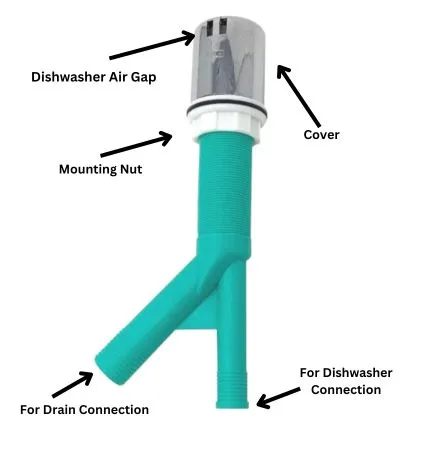
A dishwasher air gap is a small metal or plastic fitting (usually with a shiny cap) installed on the sink or countertop. Its main job is to stop wastewater from the sink or garbage disposal from flowing back into your dishwasher. The air gap creates a small “break” in the drain line — a space of air that prevents contaminated water from being siphoned into the dishwasher.
Meets Plumbing Code
In many areas, air gaps aren’t just recommended because they’re required by plumbing codes. States like California, Washington, and Minnesota mandate their use for all new dishwasher installations. Even if your local regulations don’t require one, adding an air gap is a smart way to protect your dishwasher and your family’s health.
Reduces Odors and Contamination
Without an air gap, food particles and dirty water can sneak back into your dishwasher, causing bad smells and potential hygiene issues. Installing one helps keep your dishwasher and your kitchen fresher for longer.
How Dishwasher Air Gap Works?
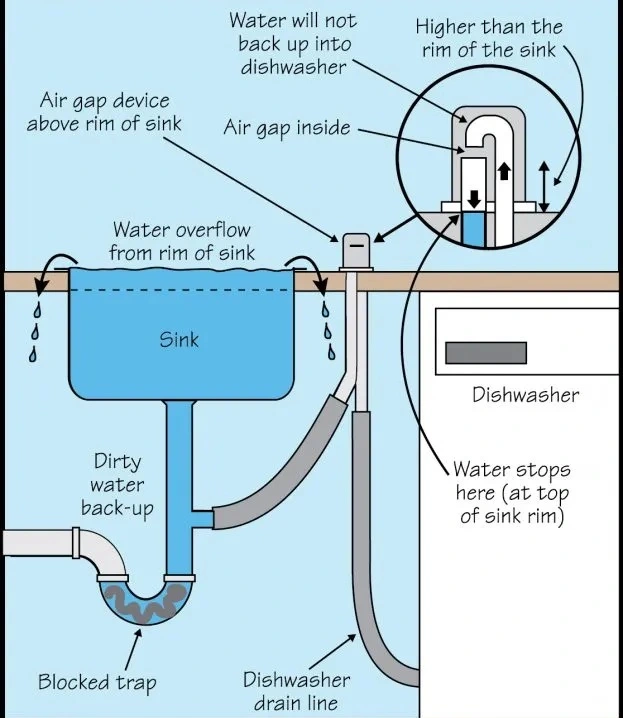
Here’s what happens when your dishwasher drains: water is pumped up from the dishwasher through the first hose into the air gap. Inside, it passes over an open space the actual “air gap” — before traveling down through the second hose into the garbage disposal. This open space is key. If your sink ever clogs or backs up, dirty water might rise into the air gap, but it cannot flow back down into the dishwasher because of that physical separation.
Think of the air gap as a simple yet powerful safeguard — it keeps contaminated water, grease, and food waste from being siphoned back into your dishwasher. Without it, a blocked sink drain could easily push dirty water into your clean dish load. By staying higher than the sink rim, the air gap ensures water overflows harmlessly into the sink instead of contaminating your dishwasher.
Tools and materials needed for dishwasher air gap installation
Before you begin installation, you’ll want to have all the essential tools and materials on hand. Here’s what you’ll need:
- Dishwasher air gap kit: Includes the decorative cap, collar, gasket, and mounting nut.
- Drain hoses: One smaller hose (around 5/8″) from the dishwasher to the air gap, and one larger hose (around 7/8″) from the air gap to the garbage disposal.
- Hose clamps: Use stainless-steel clamps to secure connections and prevent leaks.
- Basic tools: Screwdriver, adjustable wrench or pliers, and a utility knife or scissors.
- Optional: Drill with a 1⅜″–1½″ hole saw (if you need to create a new hole in the sink or countertop).
- Safety gear: Gloves, eye protection, and towels to catch any water spills.
💡 Tip: You usually won’t need plumber’s putty because most modern air gap kits include a watertight rubber gasket.
Preparing for Installation
Locate or Create the Hole
On most kitchen sinks or countertops, a pre-drilled hole is already available for an air gap or soap dispenser. This opening is usually of about 1 1/4 inch in diameter. Before you start, take a look at your sink or countertop to verify that you do have this hole. If it does, great! No need to drill, go straight to installation.
If there’s no hole in your sink or countertop, you’ll need to drill one yourself, so measure twice and cut once. Pick a spot near the dishwasher and garbage disposer for easy hose hookup, and where it can be used conveniently and with the least-aesthetic impact.
Safety First
Switch off the dishwasher and disconnect it from the electrical supply to prevent the risk of an electrical shock. Also, you should probably turn off the water to your sink to avoid any accidental leaks or flooding. Put the towels down or set a bucket below the pipes to catch any remaining water that may drip throughout the installation.
Step-by-Step Dishwasher Air Gap Installation
Step 1: Locate or Drill the Mounting Hole
Check if your sink already has an unused hole (often covered with a small metal cap). If not, mark a spot near the faucet and carefully drill a hole using the correct size hole saw. Cover the area with masking tape before drilling to prevent scratches or chips.
Step 2: Insert and Secure the Air Gap
Take apart your air gap kit. Place the rubber gasket on top of the sink, insert the air gap body through the hole, and secure it from underneath using the mounting nut. Make sure the cap’s vent holes are facing outward before tightening.
Step 3: Connect the Dishwasher Hose
Attach the dishwasher drain hose (the smaller one) to the inlet side of the air gap — this is usually the shorter nipple. Push it on securely and tighten with a hose clamp. Ensure the hose has a gentle upward curve before entering the air gap to help prevent backups.
Step 4: Connect the Air Gap to the Garbage Disposal
Find the dishwasher inlet on your disposal (a small capped opening on the side). If unused, remove the plastic knockout plug by gently tapping it out. Attach the larger hose (around 7/8″) from the outlet of the air gap to the disposal inlet. Use clamps on both ends to secure the connection.
Step 5: Test the Setup
Replace the decorative cap on top of the air gap, plug in the dishwasher, and run a quick rinse cycle. Watch for leaks and make sure water flows properly — it should move from the dishwasher, through the air gap, and down the disposal without overflowing from the top.
If you see any leaks or hear gurgling, turn off the dishwasher and tighten the clamps or check for hose kinks before testing again.
Troubleshooting Dishwasher air gap Common Issues
1. Water Overflowing from the Air Gap
If water gushes from the air gap during a dishwasher cycle, it usually means there’s a clog in the disposal or drain line. Turn off power to the disposal, clear any visible debris, and run it again to flush out the blockage. You can also remove the air gap cap and clean out any trapped gunk inside with a small brush.
2. Leaks Under the Sink
Leaks typically come from loose clamps or cracked hoses. Check all connections, make sure the clamps are tight, and inspect the rubber gaskets for wear. If the disposal knockout wasn’t completely removed, that can also block drainage and cause water to back up.
3. Water Backing into the Dishwasher
If dirty water is returning to your dishwasher, confirm that the hoses are correctly routed the line from the dishwasher should always rise above the sink rim before connecting to the air gap. Also, ensure the internal check valve (if your dishwasher has one) isn’t stuck.
4. Persistent Odors
If you notice unpleasant smells, remove the air gap cap and clean the inside thoroughly. Run ice cubes and citrus peels through your disposal to freshen things up. Regular cleaning helps keep both the disposal and air gap odor free.
Further Reading:
What is Garbage Disposal Air Switch, Installation and Complete Guide
How Much Does Garbage Disposal Installation Cost?
How to connect Dishwasher Drain to Garbage Disposal
How to Remove & Replace Garbage Disposal Splash Guard – Easy Step-by-Step Guide
conclusion
Installing a dishwasher air gap might seem like a small task, but it plays a big role in keeping your kitchen’s plumbing clean, efficient, and safe. By creating a simple break between your dishwasher and sink drain, it ensures dirty water never finds its way back onto your freshly washed dishes.
Whether you’re using a sink mounted or countertop air gap, the function remains the same, it provides a reliable, code compliant defense against backflow. Once installed correctly, you can enjoy peace of mind knowing your dishwasher is protected from contamination and odors caused by dirty drain water.
Regularly check the air gap for debris or clogs, and keep its vent clear for smooth operation. With just a little maintenance and proper installation, this small device can make a big difference in the long term health of your plumbing system and the overall hygiene of your kitchen.
The Author

I’m Muhammad Nabeel Dar, an employee in waste management and the owner of Garbage Waste Disposal with more than four years of experience helping people to control waste and garbage disposals are the best tools to control it. Read more

